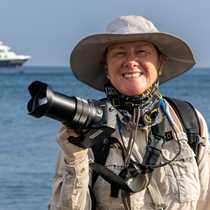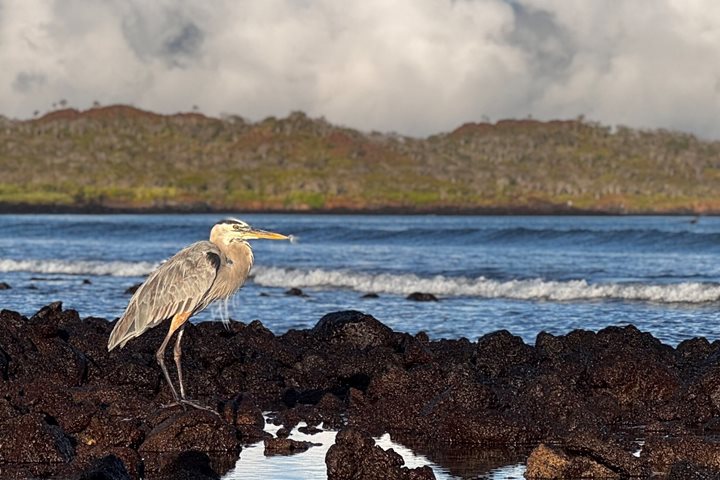At this time of year, it is normal to wake up to overcast skies, a breeze blowing and birds in the air. North Seymour is an extraordinary place. Next to an airport, yet a jewel in the wildlife crown of the Galapagos archipelago.
Yesterday we set foot in the Galapagos National Park for the very first time and saw flamingos. Today we saw how very different every island can be, one from another. Dry, arid, trees without leaves, dirt and dust on the ground. Nothing tropical about this place! Yet North Seymour was filled with life; the sound of courting frigatebirds; the clacking of beaks against the air-filled chamber of the gular pouch, air whistling through feathers in flight; sea lions calling and barking; occasional hoots and whistles from blue-footed boobies overhead. Their chicks, both very young and adolescent, would squawk at us as we passed by.
The most silent were the reptiles; both land and marine iguanas barely moved their heads. Food is scarce at this time of year, so they are focused on conserving energy and not interested in wasting any through useless movement.
The afternoon was spent exploring the island of Rábida, or Jervis, in English. The north shore is dominated by red cinder, eroded and ground down into a rubble and sand beach that lines a small bay. Beginner snorkelers from the beach, experienced snorkelers from Zodiacs; water around 72 degrees Fahrenheit, visibility good, and marine life, plenty. In fact we saw abundant fish, including scorpionfish, then along came a white-tipped reef shark…or two. Then green sea turtles appeared, then an endemic Galapagos fur seal buzzed the group and crossed paths with a Galapagos sea lion.
On the red beach for the late afternoon shore excursion, a pair of friends, Galapagos sea lion pups, tussled, wrestled and bit each other, while at the same time finding us humans rather irresistible and worthy of close inspection. Some even got a sniff and tickle on their knees!
The grand finale as the sun got lower in the sky and finally disappeared down to the west, was the spotting of whale blows. So the Captain and crew got all our wonderful Zodiacs on board, anchor was raised, and off we went to see what we could see before the dark encroached…and it was worth the attempt! Bryde's whale at the surface, close to the ship, and even a single feeding lunge! Earlier the blow of possibly a blue whale had been seen - simply by the strength and height of the blow, and the knowledge they have been seen in the area means it was likely a true identification for the record. Oh…and four planets lined up in clear skies…







